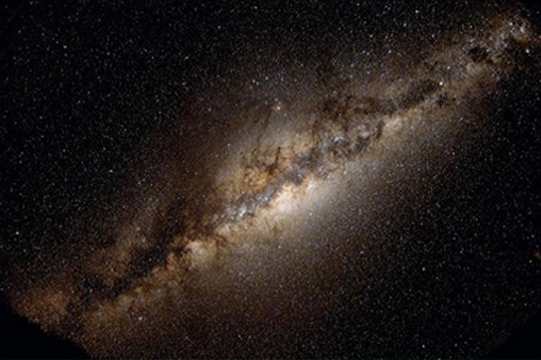|

The center of the Milky Way. Credit:
Serge Brunier
Plasmoids Refute Dark Matter
Theory
May
05, 2011
So-called "dark matter"
reactions are said to initiate gamma
rays from the center of our galaxy.
"We should remember that there
was once a discipline called natural
philosophy. Unfortunately, this
discipline seems not to exist today.
It has been renamed science, but
science of today is in danger of
losing much of the natural
philosophy aspect."
--- Hannes Alfvén
Previous Picture of the
day articles have taken issue with
the theory of dark matter, in
general, and with the idea that
"dark matter particles" can collide
and annihilate each other, releasing
vast amounts of radiation. In June
2006, the Payload for Antimatter
Matter Exploration and Light-nuclei
Astrophysics (PAMELA)
payload was launched onboard a
Resurs-DK1 Russian satellite as part
of the Russian-Italian Mission (RIM)
research program.
PAMELA's primary goal, in
conjunction with the Astrorivelatore
Gamma ad Immagini ultra LEggero
(AGILE) and Fermi Gamma Ray Space
Telescopes (formerly the Gamma-Ray
Large Area Space Telescope) is to
study the properties of high energy
signals from deep space. Such
emissions are thought possible
because "non-hadronic particles
outside the Standard Model" might be
interacting, thereby producing
bright gamma ray sources.
According to a recent
press release, Fermi has
found a gamma ray signal from the
center of our galaxy that is much
brighter than was originally thought
possible. Researchers examined many
computer models, but ultimately
decided that the only way for such
energetic radiation to be produced
was through dark matter particle
collisions.
Since the galactic center is so
dense, the unidentified dark matter
particles are "packed in" tight,
thereby increasing the chance that
they will meet and destroy each
other. One of the components of dark
matter theory is that they act like
antiparticles, as well as particles.
In other words, if two dark matter
entities meet, they appear to one
another like antimatter and convert
their individual masses into energy.
Conversely, there might be
"anti-dark matter particles" that
react with dark matter in the same
way that antimatter is said to react
with normal matter.
They do not know which process is
occurring. However, weakly
interacting massive particles (WIMPs)
with values nine times the mass of a
proton are thought to be the source
for the gamma ray light shining from
the Milky Way's core.
Consensus cosmologists believe
that dark matter is necessary, since
there is not enough gravity in the
Universe to account for galaxy
formation, or for those galaxies to
assemble into clusters. Also, galaxy
clusters should not have maintained
such rapid theoretical recessional
velocities (95% of light speed) over
the last few billion years.
Astronomers also think that a
dark (meaning "undetectable") kind
of matter must exist because stars
on the edges of spiral galaxies
revolve with the same angular
velocity as stars close to their
centers. Newtonian theory insists
that stars farther away ought to
move more slowly, so dark matter was
assumed to impart extra velocity to
them, although serious doubt about
dark matter
was already being published
when those ideas were made public.
Electric Universe proponents
share a different view regarding the
nature of the cosmos. Astrophysicist
Hannes Alfvén came up
with an “electric galaxy” theory as
early as 1981. Alfvén observed that
galaxies resemble
homopolar motors. A
homopolar motor is driven by
magnetic fields induced in a
circular aluminum plate or some
other conductive metal. The metal
plate is placed between the poles of
an electromagnet that causes it to
spin at a rate proportional to the
input current.
Galactic discs behave like the
conductive plates in said motor.
Birkeland currents flow
within galactic disks, powering
their stars. Galaxies are, in turn,
powered by intergalactic Birkeland
currents that are detectable by the
radio signals they induce. Since
Birkeland currents are drawn toward
each other in a 1/r linear
relationship, dark matter can be
dismissed when electric currents
flowing through dusty plasma are
recognized as an attractive force.
Gamma ray (and X-ray)
observations of the galactic core
also reveal a plasma torus structure
there known as a "plasmoid." High
frequency radiation from the
plasmoid is similar to that from
electrically excited stars.
A strong electromagnetic field in
the plasmoid accelerates particles
to high speed, causing them to
spiral in the resulting magnetic
field and emit X-rays and gamma
rays.
It is the Milky Way's plasmoid
that generates the glow from our
galactic core.
Stephen Smith
 New
DVD New
DVD
The Lightning-Scarred
Planet Mars
A video documentary that could
change everything you thought you
knew about ancient times and
symbols. In this second episode of
Symbols of an Alien Sky, David
Talbott takes the viewer on an
odyssey across the surface of Mars.
Exploring feature after feature of
the planet, he finds that only
electric arcs could produce the
observed patterns. The high
resolution images reveal massive
channels and gouges, great mounds,
and crater chains, none finding an
explanation in traditional geology,
but all matching the scars from
electric discharge experiments in
the laboratory. (Approximately 85
minutes)
Video Selections
Order Link
|





 New
DVD
New
DVD

